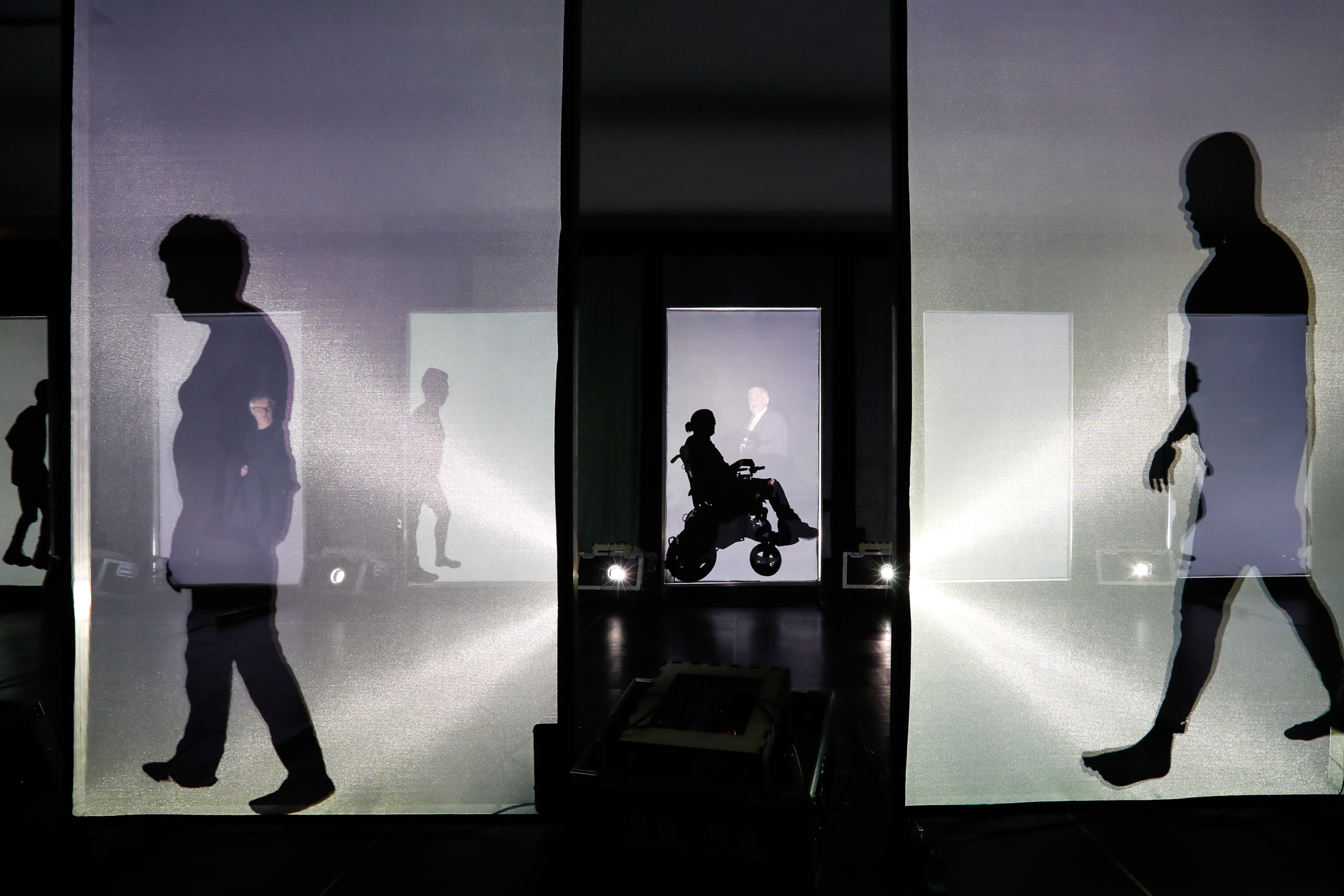Dutch original version
English
Motus Mori PERPETUUM
Maartje, Willem, Ruud, Svea and Efía share their personal gestures
23 May 2025
Seen on 22 May 2025, SPRING, Stadsschouwburg Utrecht
The people from whom choreographer Katja Heitmann has been collecting personal gestures for several years are increasingly taking shape. In the video installation PERPETUUM , they not only make themselves heard, they also show themselves, from head to toe, in all their vulnerability. With a smile and an open gaze. They come close, albeit on a screen, and it feels like a warm and intimate encounter. Wherever you stand, they look at you invitingly. Sometimes it’s uncomfortable, but above all it’s an experience that touches you.
Katja Heitmann is working determinedly on her multi-year project Motus Mori. For this project, she and her dancers engage in conversation with people and collect characteristic gestures, postures and peculiarities. Thousands of people worldwide have contributed to the ever-growing archive.
This led, among other things, to Museum Motus Mori, in which dancers stand on pedestals and perform gestures they collected earlier that day during interviews with spectators, and the installation Motus Mori RELIQUIEM, in which the audience hears people talking about their personal gestures through headphones and spectators then imitate them to integrate them into their own bodies. CORPUS was a captivating performance featuring people from Leeds, many of whom were elderly or disabled.
PERPETUUM is the latest addition to the series. Here, too, people share gestures that make them recognisable. They introduce themselves: Stijn, Marijn, Jos, Feicko, the girls Svea and Efía, twenty people in total, although not all of them can be seen at the same time. The audience sees an installation with twelve tall screens. They are arranged in a rectangle, six video screens on one side, six on the other. Spectators can walk around them. The projections on the screens are visible from multiple angles.
Accompanied by repetitive, edited (guitar) music by composer Sander van der Schaaf, silhouettes shuffle across the screens. They follow each other from one screen to the next, and for a moment the image is reminiscent of illustrations of human evolution.
One walks with a slightly curved back, another moves with difficulty, a third walks straight as a die. Others move around with a walking stick with legs, a walker or in a wheelchair. One has long hair, another a beard, one walks in sturdy shoes, another barefoot. The diversity of humanity and multiple forms of disability pass by. Not only on the screens, the silhouettes can also be seen in XXL format on the walls of the darkened room where the installation is set up.
After a while, it goes completely dark, the figures remain standing and turn to face the viewer. Silhouettes and shapes change into clear images. Stijn is clearly visible: his face, his clothes, the colour of his shirt, his wheelchair. Maartje, Ruud, Willem and the others are also visible. They say their names and look at you intently. It feels as if you are standing face to face with the people, even though you know it is a video recording. That feeling is intensified when they take a big step forward and stand right in front of you. Enchantment takes over from reality for a moment. The characters want to share their personal gestures with others, they say.
A man talks about his two artificial knees and how difficult it is to get up when he is sitting on the floor. Friends Svea and Efía, still girls, show what boredom looks like. Maartje talks and shows how she bends her arms and picks at her elbows. Joost is also one of the people on the screens. He is a regular visitor to the theatres in my city.
Suddenly, I recognise him and see that he is part of this installation. He is the man with the walking stick with legs. I thought I recognised him from his silhouette. He looks at me from the screen, smiles and says that he holds his other arm firmly with one hand to regain control of his body. This is a response to his disability. Would I like to take this movement home with me?
PERPETUUM lasts twelve minutes. That’s short. Towards the end, the people fade away and turn back into silhouettes, before resuming their journey. The installation repeats itself continuously and never stops. New audiences enter the space, but you are also allowed to stay longer and relive the experience. I would definitely do that. All those people, all those experiences, you can’t take it all in in twelve minutes.
What’s more, the atmosphere, the intimacy, the personal touch, the combination with soft, dreamy music is very pleasant to immerse yourself in. By taking more time, I suddenly discover the man who, as a personal gesture, places both hands on his forehead and then pulls them down tightly over his face. I won’t forget the look he gives when he does that. I also hear that gestures are sometimes passed down from generation to generation within families.
Katja Heitmann is working on a long series of performances and installations, all based on the same source: the individual movements of people. You could say that this source has been exhausted at some point, that it is time for something new. But Motus Mori PERPETUUM proves the opposite. It becomes increasingly penetrating and exudes respect for fellow human beings.

